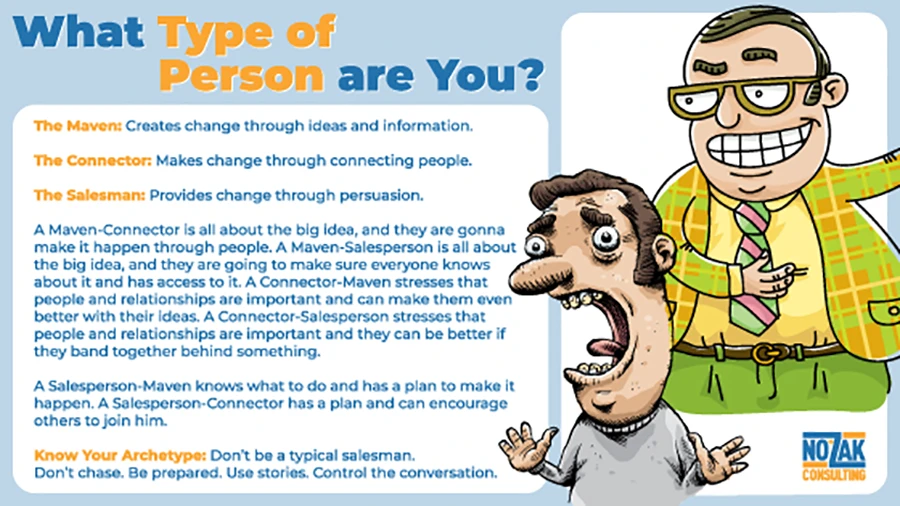Don’t be a typical salesman.
In movies, salesmen are written as sleazy purveyors of crap no one wants. They are depicted as snake oil salesmen, used car salesmen, or sales sharks that smell blood in the water.
Traditional sales consisted of badgering, strong-arming, and pressure, but there were also numerous less-effective ways to sell. For example, some use the “excited” approach where they have to show immense enthusiasm by being loud and excited about the product. They are loud and proud, trying to get you to buy their item or service through loud decibel levels and manic exuberance, showing wild and deranged energy.
That type of sales does not work anymore. A successful salesman needs to be calm and speak like a professional. Don’t be a caricature, be a professional.
You must have a conversation with your potential client to find out their needs. Ask questions to find out their needs and pain points. You are like a miner, digging and sifting for nuggets of information. You can find these nuggets by listening, and listening is more important than talking. Listen to what your prospective customers are saying to you and have a real conversation about their needs.
Don’t chase the potential customer.
A successful salesperson must be extremely confident without being obnoxious. You should start the relationship from a place of power. Separate yourself from the rest of the crowd by talking from a place of authority but empathize with the customer by listening to their needs.
It doesn’t hurt to let the prospect know that you are in high demand and scheduling an appointment right then is crucial.
Also, ask questions, discover their needs, be calm, and speak with conviction. Go over past emails, phone calls, and conversations with the prospect to give you an edge. Being an expert on the situation forces customers to believe that you have the solution they need. Then, your phone starts ringing, and the customer is now chasing you.
Be prepared.
In the past, salesmen believed that “if you are positive then everything will work out.” That doesn’t work, and it never really has. In sports history, the greatest professional athletes of all time practiced and prepared constantly. They spent hours and hours learning their opponents’ strengths and weaknesses in order to have a better understanding of them and how to overcome them.
Preparedness will get you a lot farther than the power of positive thinking.
Just like great athletes, some of the greatest salesmen are able to think several steps ahead. Great salesmen can anticipate where the conversation is going and have the solutions ready.
You need to know every objection your potential customer might have and you’ll have the information to handle it.
Confidence can elicit a positive response from a prospective client. However, a lack of preparation leads to a lack of confidence. Obviously, the opposite is also true. Preparation leads to confidence, and, in turn, your prospects will gain confidence in you.
Use stories.
Facts tell, stories sell.
Tell a story about the product. Facts describe the item’s function, but an interesting story can make the item or service stand out in an industry where there are hundreds, maybe thousands of other choices. An origin story about the product or a positive customer story about how the item or service made an impact on their business can be the difference in a sale.
Some companies use famous actors or athletes to sell their product, and that automatically makes the item a sought-after commodity. That is part of the item’s story.
Be sure to inject stories into every item or service you are selling.
Control the conversation.
Most prospective customers want the bottom line and they want it fast, sometimes at the beginning of the conversation. The main question asked is: “How much does it cost?”
As a salesperson, once you give the customer a price for the item, you lose control. If the customer balks on the price, you find yourself in “justification mode.” Take the time to figure out their needs. Ask the customer questions and get them to tell you what their needs are and you can use your preparedness to fight off any objections.
If you do this, you now have to combat every objection they have without knowing their actual needs. This almost automatically forces you to justify the price without knowing what they need.
Try to get the prospect to discuss their budget, giving you a starting point. When the prospect gives you their budget, you’ve now been given information that can only help you close the sale. Again, you must find out their needs before offering a price.
If the potential customer is persistent on knowing how much your item or service costs, give an open price range by saying “It could range from $1,000 to $5,000,” or answer that same question with “it depends on what your needs are.” Then, the prospect will start openly discussing their needs with you — something that generally won’t happen if you give the price right at the beginning of the conversation.
Provide a great experience.
Once you’ve closed the sale with the customer, the sale doesn’t stop there. You’ve already worked so hard to get the sale and now you need to deliver the product or service. It’s now up to you to provide a great experience for the customer which can lead to referrals and more customers.
What type of person are you and why does it matter?

In order to be a good salesman, you need to know what archetype you are, and how to use it. According to author Malcom Gladwell, when it comes to people, there are three archetypes: The Maven, The Connector, and the Salesman.
The Maven
The Maven creates change through ideas and information. It’s all about ideas and information. They are process and systems people, and they have the ideas and information that can get a project started.
The Connector
The Connector makes change through connecting people. They always know who to call to get the job done, and they have a list of experts at their disposal. They have a network of contacts and don’t really deal with ideas or information. They connect people with other people that have ideas or information.
The Salesman
The Salesman can provide change through persuasion. They have an amazing ability to get a customer to buy what they are selling. They use stories to get people on their side, and they use the power of persuasion to sell an item, an idea, or a service.
Knowing your archetype is important because a successful businessman plays to his strengths, and knowing which type of person you are can only lead to success.
There are actually six categories because someone can have primary and secondary traits, involving the three archetypes: the Maven, the Connector, and the Salesman. The first listed is the primary trait and the second listed is the secondary trait.
A Maven-Connector is all about the big idea, and they are gonna make it happen through people.
A Maven-Salesperson is all about the big idea, and they are going to make sure everyone knows about it and has access to it.
A Connector-Maven stresses that people and relationships are important and can make them even better with their ideas.
A Connector-Salesperson stresses that people and relationships are important and they can be better if they band together behind something.
A Salesperson-Maven knows what to do and has a plan to make it happen.
A Salesperson-Connector has a plan and can encourage others to join him.
In order to be a good salesman, you must know what kind of person you are and how to use your strengths during the sales process.
Know Your Archetype
Don’t be a typical salesman: Don’t use badgering, strong-arming, or pressuring techniques. Be sure to listen to your prospective customer to find their needs and pain points.
Don’t chase: Be an expert on the situation and speak from a place of authority. The prospect needs to know that you have the only solution to their problems, and they could start calling you instead of the other way around.
Be prepared: Just being positive won’t cut it. You must be prepared, and it will get you a lot farther than the power of positive thinking. Have an answer to any and every objection the customer might have.
Use stories: Facts tell, stories sell. Facts describe the item’s function, but an interesting story can make the item or service stand out.
Control the conversation: Don’t just give them the price and wait for an answer. Take the time to figure out the customer’s needs. Ask them questions and get them to tell you what their needs are, and you can use your preparedness to fight off any objections.Know what archetype you are: You are either a Maven, a Connector, or a salesman, and knowing which archetype you are can only lead to making you a better salesperson.
